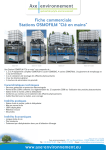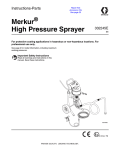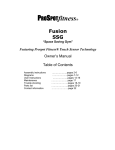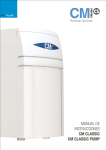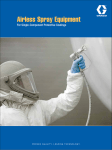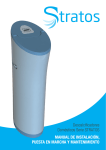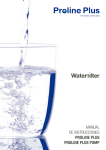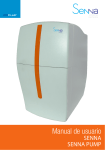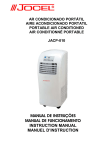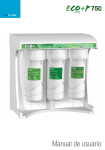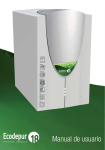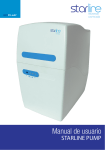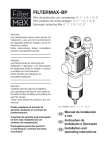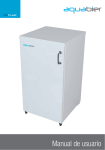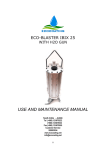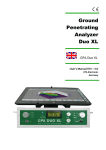Download INSTRUCTION MANUAL SINTRA PRESSURE TANK CS
Transcript
INSTRUCTION MANUAL SINTRA PRESSURE TANK CS POSITIION DESCRIPTION CODE 1 2 3 4 5 6 7 8 9 10 11 12 13 14 15 16 17 18 19 20 21 22 23 24 25 26 27 28 29 30 31 32 33 34 35 36 37 38 39 40 41 42 43 44 45 46 47 48 49 50 51 52 53 54 55 56 57 58 262702 771600 274700 294600 275700 658300 292900 291604 291803 280400 291902 274400 263800 263600 274600 652401 275400 294801 294100 282800 653703 281600 278800 281700 279000 296800 292500 264700 281000 265000 264901 295204 272400 272000 / 272100 276800 276900 282400 282500 295800 267700 274500 276200 295202 294200 267500 764402 293500 764402 274000 743303 SINTRA lower cover (white) 10L pressure tank Leaking sensor JACO elbow thread 1/4"- tube 3/8" JACO elbow thread 1/8"- tube 1/4" with SS check valve JACP tee 1/4"-1/4"-1/4" SINTRA metallic frame PJK-260 electronic board SINTRA upper cover (white) 2012 membrane housing GAC-Ag post-filter SINTRA rear cover (white) CS 5mm sediment filter 3/8"-1/4" QC reducing elbow CS GAC filter SINTRA front cover (white) SINTRA upper front cover (orange) SINTRA buttons SINTRA front cover (orange) JACO elbow thread 1/8"- tube 1/4" Tank valve 3/8" Elbowed adaptor for tank valve 3/8" JACO elbow thread 3/8"- tube 1/4" Flushing solenoid valve 24V JACO male run tee thread 1/4"-tube 1/4" Inlet solenoid valve 24V Minimum pressure switch QC tee 3/8"-1/4"-3/8" Display electronical board QC bulkhead 1/4" QC stem elbow 1/4" QC bulkhead 3/8" QC stem elbow 3/8" Robin faucet 75 GPD RO membrane 1/4" drain clamp Faucet female adapter thread 7/16"-tube 3/8" Ball valve 1/4" Free nut 3/8"-3/8" wall adaptor, drill 1/4" Transformer 220-24V White 3/8" polyethylene tube White/Blue 1/4" polyethylene tube Insert 1/4" Insert 3/8" Locking clip 1/4" Locking clip 3/8" Electronic board box Double mounting clip 2 1/2" JACO elbow thread 1/4"- tube 1/4" Double male connector 1/4" Bulkhead for power supply Maximal pressure switch 20-40 PSI Single mounting clip 2 1/2" Base double mounting clip 2 1/2" UP-7000 pump 24V Base double mounting clip 2" JACO straight male conector pipe 1/4"-tube 1/4" (BLUE) Higienization kit SINTRA COMPONENTS DESCRIPTION e d o k a n j i h g l a b c d e f g h i j k l m n o Minimum pressure switch Inlet solenoid valve 24V Flushing solenoid valve 24V CS 5mm sediment filter CS GAC filter UP-7000 pump 24V 75 GPD RO membrane Maximal pressure switch 20-40 PSI Tank valve 3/8" 10L pressure tank GAC-Ag post-filter Leaking sensor PJK-260 electronic board Quality probe Display electronical board e d k m a g j f c b SANITIZING KIT PDA FCT TRANSFORMER ECOLOGICAL DIRECT ACCESS AQUASTOP CLICK QUALITY CONTROL JOHN GUEST LOGICAL FILMTEC Portable programmer. Configurable feature and parameters. Sanitization Kit for domestic osmosis. 00:00:00 External transformer Automatic warning system for filter change Easy maintenance. Direct access. Control system for a reduced water consumption. Safe binding and locking of connections. Automatic leak detector. Water quality control. High quality components . NSF certified. Configuration acording to the water quality. DOUBLE FLOW Easy and fast filling system. High quality membrane DOW CHEMICAL. NSF certified. Ag Plata SILVER Gac silver carbon. NSF certified. CALGON CARBON GREEN FILTER CS AUTO FLUSHING INSERT The content of the filters i made by CALGON (USA). NSF-Quality certified. Automatic membrane membrane, ELECTROVALVE Electrovalve with safety filter. New top security filter and easy maintenance. Safety system for tube connections. Contents Página 01. PRESENTATION 2 02. INTRODUCTION 2 02.1 What is natural osmosis and reverse osmosis? 02 02.2 How does the membrane of your system work? 3 02.3 Concentration of salt and other substances reduced by its reverse osmosis membrane 3 02.4 The effect of pressure and temperature in a reverse osmosis system 3 02.5 The effect of a concentration of sales in the feed water 4 03. TECHNICAL CHARACTERISTICS 5 04. UNPACKING AND VERIFCATION OF CONTENT 5 05. PRE-WARNINGS 6 05.1 Conditions for the proper working of the equipment 06 6 05.2 Installation of the equipment 6 05.3 Operation and maintenance 6 05.4 Use of equipment 7 05.5 Recommendations for the proper use of the osmosis water 7 06. INSTALLATION OF THE SYSTEM 8 06.1 Step by step installation0 9 07. START-UP AND HYGIENISATION 12 08. WORKING OF THE SINTRA EQUIPMENT 16 08.1 Description of Operation 016 08.2 Interface with the user 17 09. MAINTENANCE / CONSUMABLES 18 09.1 Maintenance 18 09.2 Hygienisation 21 10. GUIDE FOR THE IDENTIFICATION AND RESOLUTION OF PROBLEMS 22 11. MAINTENANCE SERVICE MANUAL 24 12. EC STATEMENT Interior cover 13. GUARANTEE Interior cover 14. INSTALLATION SHEET AND PUTTING INTO OPERATION OF THE SYSTEM Back flap 1 1. Presentation 2. Introduction 1. PRESENTATION 2. INTRODUCTION Welcome to your reverse osmosis SINTRA system. Thank you and congratulations. You have made a great choice in chosing the reverse osmosis SINTRA Series system. The SINTRA series systems are some of the best domestic appliances for the improvement of the characteristics of water that you can find on the market. The quality of the water in our environment is getting worse every day. The reality of this is what has driven us to design and manufacture this domestic osmosis system in order to make water of the highest quality available to you. Your SINTRA Series system provides you with different benefits and advantages: The SINTRA Series system provide you with a better quality of life. You will perceive an improvement in the taste of your drinking water, and likewise in the taste of your coffees, juices or icecubes. Cooking with the purified water will heighten the taste of the food. Your family will have healthier water. The water provided is water that has a LOW MINERAL CONTENT. Osmotizad water helps prolong the life of your domestic appliances and is ideal for steam irons, coffee makers and humidifiers. • It is a physical system that does not use or add chemical products to the water. • Provides high quality water. • Ensures high production. • Has low maintenance costs. • Convenient and easy installation. It is important that you keep and read this manual carefully before the installation and operation of the system. Should you have any queries about the use, installation or maintenance of this system, please contact the technical assistance service (T.A.S.) at your distributor. 2.1 What is natural osmosis and reverse osmosis? Natural osmosis or direct osmosis is the most common in nature, as a semi-permeable membranes make up part of the majority of organism (for instance, plant roots, organs in our body, cellular membranes etc.) When two solutions with different concentrations of salts are separated by a semi-permeable membrane, there is, naturally, a flow of water from the solution that has a lower concentration of salts to that of higher concentration. It is necessary to apply sufficient pressure, of the water with a higher concentration, against the membrane, in order to stop this tendency and natural flow of the system. This process is called reverse osmosis. At present, reverse osmosis is the best method to produce pure water via a physical system (without using chemical products). As has been explained, its working principle is based on the same as that of our own organism, where water is distributed by natural osmosis. The human body is mainly made up of water: Woman> 55 – 65 % Man > 65 – 75 % Child > 80 % An adult body contains between 38 and 48 litres of water, 30% of which is found in the cells. This water in the body, which is almost completely recycled every 15 days, is the basis for the transportation of nutrients, oxygen to cells, the elimination of waste and it controls the body temperature. 2 2. Introduction We consume an average of 2.2 litres of water per day, including the water found in foods. 2.2 How does the membrane of your system work? FEED WATER FEED PRESURE Membrane The water that is going to be purified exerts pressure on the semi-permeable membrane, to the extent that part of the same is able to pass through the pores of the membrane (osmosis water), while the remainder of the water (rejected water or that with high concentrations of salt) are diverted to the drainpipe. Given that the diameter of the membrane pores are less than 0.0001 microns, only the water molecules and a certain amount of minerals (sodium, potassium, magnesium etc.) are able to get through, eliminating the excess minerals that our body does not need, as well as the bacteria, heavy metals, pesticides, chemical products, etc. The chemical composition and concentration of salts and other substances of the water on entering the reverse osmosis system has an affect on the purified water. The TFC reverse osmosis membrane of your SINTRA Series system can reduce the concentration of the elements and compounds, among others, outlined in the following tables. Inorganic ELEMENT/COMPOUND SODIUM CALCIUM MAGNESIUM ALUMINIUM COPPER NICKEL ZINC BARIUM CARBONATES CHLORINE BICARBONATES NITRATES PHOSPHATES FLUORIDE CYANIDE SULPHATES BORON ARSENIC REDUCTION 90-95% 93-98% 93-98% 93-98% 93-98% 93-98% 93-98% 93-98% 93-98% 90-95% 90-95% 45-55% 93-98% 93-98% 90-95% 90-95% 40-45% 93-98% PURE WATER Organic REJECTION DIAMETRE OF RO MEMBRANE 0.0001 μm PORE 2.3 Concentration of salts and other substances reduced by the reverse osmosis membrane DIAMETRE OF 5 µm FILTER DIAMETRE OF 1 µm FILTER SIZE OF BACTERIA SIZE OF A VIRUS ELEMENT/COMPOUND HUMIC ACIDS GLUCOSE ACETONE ISOPROPANOL ETHYLBENZENE ETHYPHENOL TETRACHLORETHYLENE UREA 1,2,4 TRICHLOROBENZE 1,1,1,TRICHLOROTHANE REDUCTION 98% 98-99% 70% 90% 71% 84% 68-80% 70% 96% 98% 2.4 The effect of pressure and temperature in a reverse osmosis system The membrane usually rejects more than 95% of salts, however the percentage may vary depending on the quality of the water, the temperature and pressure. 3 2. Introduction Conversion factors 2.5 Effect of the concentration of salts in the feed water BY PRESSURE PRESSURE (BARS) 0,70 1,00 1,50 1,75 2,50 4,00 4,50 4,90 5,20 5,80 CONVERSION FACTOR ON PRODUCTION 0,70 0,25 0,33 0,42 0,58 1,00 1,08 1,17 1,25 1,42 REJECTION OF SALTS 84 88 90 92 93 95 95 95 95 95 BY TEMPERATURE CONVERSION FACTOR TEMPERATURE (ºC) ON PRODUCTION 6 0,38 8 0,45 10 0,52 12 0,59 14 0,66 16 0,70 18 0,77 20 0,85 22 0,88 25 1,00 28 1,09 30 1,16 32 1,23 34 1,30 80 – 90% > MEDIUM QUALITY 70 – 80% > LOW QUALITY Below 70% the life of the membrane is finished. Using a conductivity metre or a TDS measurer compares the conductivity of the feed water with that which comes out of the membrane and obtains the percentage of rejection of salts. 4 Conductivity of R.O. water Conductivity of feed water MAXIMUM TDS OF FEED* MINIMUM PRESSURE OF FEED TO MEMBRANE** Up to 200 μm 3,5 bars between 200 and 500 μm 3,8 bars between 500 and 800 μm 4,0 bars between 800 and 1200 μm 4,3 bars between 1200 and 1500 μm 4,5 bars between 1500 and 1800 μm 4,75 bars between 1800 and 2000 μm 5,2 bars counter-pressure, a hardness of 15 °F and corrected salinity with NaCl. ** The pressure shown is calculated for a production of 61/h. 90 – 95% > MAXIMUM QUALITY (- Table of pressure in relation to the TDS ** The test is carried out with a 50 GPD membrane at 14 °C, without The life of the membrane is evaluated by the percentage of salts rejected. Rejection of salts % = 1 The concentration of salts and substances in the water to be treated influences the capacity of the production of osmosis water by the system, to such an extent that the greater the concentration of salts in the water to be treated, the greater the pressure that is necessary against the membrane in order to exceed the natural osmotic pressure and to guarantee a minimum flow of osmosis water. ) x 100 3. Technical characteristics 3. TECHNICAL CHARACTERISTICS CHARACTERISTICS OF SINTRA MODEL DIMENSIONS (height x width x depth): 400mm x 250mm x 430mm. WEIGHT: 14 kg. FEED TEMPERATURE (maximum / minimum in °C): 40ºC / 2ºC. TDS FEED (maximum): 2000**ppm. FEED pressure (maximum / minimum): 2.5 / 1 bars. (100-250 kPa.) NOMINAL PRODUCTION: 200 LPD**. MEMBRANE: Type 1 x 1812 75. MEMBRANE PRODUCTION: 75 GPD*. Softened water with 250 ppm. T: 25 ºC. 15% conversion Pressure against membrane: 3.4 bars (without counter-pressure). PUMP: Booster. MAX ACCUMULATION. (pre-charged tank at 7 PSI): 5’5 litres. ELECTRIC CURRENT: 24 Vdc. 48 W. ELECTRIC ADAPTOR: 100-240V. 50/60 Hz. 24 Vdc 1’25 A MANUFACTURER: Manufactured by PURICOM WATER IND. CORP. (Taiwan) for: PURICOM EUROPA. Pol. Ind. L’Ametlla Park. C/Aiguafreda 8. 08480 L’Ametlla de Vallès. Barcelona. España. T+34 902 305 310. F+34 936 934 329. * Levels may vary some +/– 20%. ** For salinity up to 2000 ppm, consult the pressure table in relation to the TDS in section 2 of the present manual. For salinity above 2000 ppm, first consult your distributor. See section 5 WARNINGS. 4. Unpacking and verification of contents 4. UNPACKING AND VERIFICATION OF CONTENTS It is important that prior to installing and starting the system you check the box and condition of the system with the objective of guaranteeing that it has not been damaged during transport. Any claims for damages during transport must be presented together with the delivery note or invoice to the distributor, including the name of the carrier, within a period of 24 hours following the reception of the goods. Remove the system and accessories from their carton packaging; take away the protective packaging. Throw the plastic bags away or keep them away from children as they may cause them harm. You shall find the following sets and elements: COMPONENT * Domestic osmosis system AMOUNT 1 Faucet + Assembly accessory kit (34) 1 Kit for drain connection (36) 1 Wall adaptor for socket (39) 1 Blue manual ¼” inlet valve (38) 1 Power supply and cable connection (40) 1 SINTRA Instructions manual 1 Blue ¼” tube for drain connection (42) 150 cm White ¼” tube feed and faucet connector (41) 300 cm Reverse osmosis membrane 75 GPD (35) 1 Membrane housing wrench (49) 1 * No. of parts on flap. The packaging material can be recycled and must be thrown away in the appropriate selective recycling bins or the specific centre for the collection of waste material. The machine that you have acquired has been designed and manufactured with high quality materials and components that can be recycled and reused. This product must not be thrown away into the usual urban rubbish bins. When you want to throw the machine away, it must be taken to a specific local centre for the collection of materials, stating that it has electric and electronic components. In order to obtain more information about how to dispose of your electrical and electronic machine once they have fulfilled their use, contact the local authorities, the management of urban waste service or the establishment from which you acquired the machine. The proper collection and treatment of the machines that can no longer be used contributes to the preservation of natural resources and also to avoiding potential public health risks. 5 5. Pre-warnings 5. PRE-WARNINGS The domestic systems of the SINTRA series, ARE NOT POTABILIZATION SYSTEM. Should the water to be treated come from a public water supply (and as such complies with the legislation in force RD 140/2003), the domestic systems of the SINTRA series, significantly improve the quality of the water. agua. Should the water to be treated not come from a public water supply, that is, from an unknown source, a physical-chemical and bacterial analysis of the water shall be necessary, with the objective of ensuring its proper purification applying the proper techniques and systems appropriate for each case, PRIOR TO THE INSTALLATION of the system. Contact your distributor in order to obtain advice about the most appropriate treatment for you. The FT-Line series systems help you to find the most appropriate pretreatment. Contact your distributor for more information. FT Line PRE Ref.: 795407. For the pre-treatment of domestic osmosis. 5.1 Conditions for the proper working of the system • Do not use hot water in the system (T > 40 ºC). • The room temperature must be between 4 ºC and 45 ºC. • The SINTRA series system incorporates a pump. Should the pressure system be superior to 3 bars, a safety valve should be attached prior to water entering the system, set at a maximum pressure of 2.5 bars. (Ref. 577603). • For water with salinity higher than 2000 ppm contact your distributor. • It is recommended that you decalcify the water to be treated or that it has a maximum hardness of 15 ºF in order to obtain the optimum performance of the system. • Should the water to be treated have a level of hardness superior to 15 F, the life of the membrane may be reduced and also the performance of the system. It is recommended that you brush the membrane for 15 seconds once a day (Read section 9.3 Flushing, which describes how this should be carried out). • Should the water to be treated contain: · high concentrations of iron and magnesium (superior to 1ppm on average in the rejection of the machinery), · prolonged hypochlorisations. · sludge or turbidity superior to 3 NTUs, · a concentration of nitrates superior to 100 pmm. · a concentration of sulphates superior to 250 pmm, contact your distributor so that they can recommend the most appropriate pre-treatment for you, and as such ensure the proper working of the machine so as to avoid damage to components and guarantee the quality of the water supplied. 6 FT Line 82. Ref.: 795500. 5 μm filtration. FT Line 83. Ref.: 795501. Activated carbon GAC. FT Line 85. Ref.: 795503. Cationic resins for decalcification. FT Line 87. Ref.: 795502. Regulation of pH and remineralisation of acidic water. FT Line 88. Ref.: 795504. Granulated carbon active GAC with silver. FT Line 89. Ref.: 795505. Mixed resin base for demineralisation. FT Line 90. Ref.: 795506. Granulated carbon active GAC with silver and silico-phosate. 5. 2 Installation of the system • Should it be necessary to condition the installation of the home in order to install the system in the foreseen location, it must be carried out in accordance with the RIW (Basic rules for the interior installation of water supplies) UNE 149201 (dimensioning of the water installation for human consumption within buildings) and acording to national regulation in force. • The SINTRA series system requires an electrical socket that is at least 1 metre away. 5. Pre-warnings • The location foreseen for its installation must have sufficient space for the machine itself, its accessories, connections, and to carry out maintenance comfortably. • Under no circumstances must the system be installed without a cover. • The systems should not be installed next to a heat source or where it receives a direct flow of hot air (dryer, refrigerator, etc.) • The surroundings and setting where the system and tap are to be installed must meet appropriate hygiene-sanitary conditions. • Avoid external drips from pipes, drains etc. onto the machi- • Special attention must be paid to the regular cleaning and hygiene of the faucet of the osmosis system, and especially during the periodic maintenance. Use the Oxibac spray (Ref. 65220) for this and disposable kitchen paper or a multiuse cloth for cleaning the kitchen. Special attention must be paid to the regular cleaning and hygiene of the faucet of the osmosis system, and especially during the periodic maintenance. Use the Oxibac spray (Ref. 65220) for this and disposable kitchen paper. Under no circumstances must you use a hand towel or a multiuse cloth for cleaning the kitchen. nery. 5.3 Start-up and maintenance • The SINTRA systems, needs to undergo periodic maintenance carried out by qualified technical personnel, with the objective of guaranteeing the quality of the water produced and supplied. • The consumable elements must be substituted with the frequency indicated by the manufacturer (See section 9. Maintenance). .• The system must be hygienised periodically and prior to its start up. • Following the start up, the first two deposits must be thrown away. • The system must be maintained by qualified technical personnel, carried out under the proper hygienic conditions, with the objective of reducing the risk of internal contamination of the machine and its hydraulic system. (For more information contact the technical service of your distributor). 5.5 Recommendations for the proper use of the osmosised water • If you want to feed any other consumption point with osmosis water (such as a fridge with an ice-cube dispenser, another faucet, etc.), the piping should not be done with a metal tube, as this will give the water a bad taste. Use a similar plastic tube (Ref. 272000). • The water supplied by the domestic osmosis systems has a LOW SALT CONTENT. The mineral salts required by the human body are provided by food, especially by dairy products and to a lesser degree by the water we drink. • We recommended that you do not use aluminum utensils for cooking with osmosised water. 5.4 Use of the system • When you are going to be away from home for more than a week close the water inlet, empty it and disconnect the electric current. On your return connect the electric current of the same, open the inlet and empty the reservoir tank twice before consuming the water. • Following a prolonged period (more than a month) during which the system has not been in operation or produced water, contact your distributer in order to carry out the proper hygienisation and maintenance. • In order to improve the performance of the system, extract full jugs and bottles and avoid the occasional extraction of glasses of water. 7 6. Installation of the system 6. INSTALLATION OF THE SYSTEM The installation of your SINTRA osmosis system must be carried out by qualified personnel from an authorised technical service. Follow the recommendations in Section 5 of this manual. Given that the apparatus that you are going to install improves the quality of the water that you are going to consume and is considered a food, all of the tools that you are going to use for the assembly and installation must be clean and under no circumstances contaminated or impregnated with grease, oils or rust. The work must be carried out under adequate hygienic conditions, taking the necessary precautions with everything related to the materials that are going to be in contact with the water to be treated or consumed. (For more information contact the distributor). The most usual place for the installation of the system is under the sink in the kitchen or in a cupboard next to it. TOOLS FOR INSTALLATION MAINTAINANCE AND START-UP OPERATION TOOL REFERENCE - 1 Vice grip pliers - 2 Drill - 3 12 and 6 mm drill bits - 4 652103 5 - 6 No. 2 Allen wrench No. 14/15mm double socket wrench - 7 Wheel support for compact system 795800 8 Hygienising hand gel 900117 9 - 10 Teflon tape Cutter - 11 206601 12 205200 + 277100 13 Portable pressure measurer 268100 14 Portable conductivity measurer 267900 15 Chlorine analyser 271700 16 Connectors quick disassembly wrench 289200 17 Oxibec spray 652200 18 Hygienisation kit 743303 Membrane housing wrench filter housings + 2 x ¼ connections CONTENTS: test holder, gloves, 2.5ml syringe, paper towels, 19 Jar for mixing and OSMOBAC disinfectant Hand metre 270700 20 RS-232 interface PC connection 761900 21 Portable model PC connection 653105 Contact your distributor for further information. 8 2 3 4 5 6 7 8 9 10 11 12 13 14 15 16 17 18 19 20 21 IMAGE Adjustable wrench Edible glycerine 1 6. Installation of the system 6.1 Step by step installation 1. Once it has been decided whether to put the tap on the counter top or sink (usually in the corner), a hole is drilled in the same with the 12mm bit, to pass the threaded connecting pipe through Image 22. Use the metal escutcheon to choose the location of the drill. If the metal escutcheon of the tap creates any difficulty in its assembly due to the geometrics of the counter-top or fridge, use the rubber joint supplied instead of the metal escutcheon in order to assemble the tap. 22 24 26 25 CLOSED 27 23 Choose the bit and the type of drill that is appropriate for the material in question. 2. Prior to this, insert the metal escutcheon and a thick flat rubber joint into the connecting pipe (these must be on the upper part of the counter-top). Then pass the threaded connecting pipe through the hole. Once this is done it is, on the bottom end of the connecting pipe you connect: the rigid plastic washer, the grower washer and the hexagonal nut. They should be tightened together with the No. 14/15mm square wrench, until the tap is completely static and properly positioned. The tap will be positioned as required after the final tightening (it is recommended that the tap handle is orientated towards the exterior of the counter top). Image 23. If the counter-top is thicker than that of the connecting pipe of the tap, you can use the tap extension (Ref. 261900). 4. Following this you should make the hydraulic connection of the apparatus to the network. As the system is under pressure the stopcock situated in the cold water outlet must be closed. Image 26. Depending on how old the installation is, there may be no right angle valve and that it is necessary to turn off the general stopcock in the home. Immediately afterwards, depressurise the installation by turning on the tap of the sink and wait until water stops coming out of it. 3. Connect the faucet to the permeated water line using the special female adapter (#37), Image 24. Interconnection with the system will be made using 3/8” white pipe (#41), as showed in image 25. In order to carry out all of the connections use a longer tube, so as to facilitate the movement of the system once installed and to not unnecessarily disconnect or make access to the same more difficult. 9 6. Installation of the system Make sure that the connection to the apparatus is going to be carried out in the cold water pipe connection. If the connection is made in the hot water pipe it may damage important components of the system. (Generally the cold water pipe connection is found to the right). Unscrew the connection of the hose or the flexible pipe, image 28. Have a recipient or cloth ready to collect or wipe up the water that may come out of the flexible pipe when you unscrew it. Insert it into the connection in the wall and the valve or flexible pipe to the ½” wall adaptor, part No. 39 on flap. The ½” flat joint that is inserted makes it unnecessary to use a sealant. (Teflon wire, liquid Teflon, hemp twine, etc.), image 29. Assemble the ¼ manual in-let valve, part No.38 on flap in the lateral hole of the wall adapter. Image 30. 28 part No. 39 on flap 29 part No. 38 on flap 30 CLOSED OPEN To ensure the proper installation and water-tightness of the connections made, open the right angle entry valve (or where applicable the general stopcock), first making sure that the ¼” feed valve has been turned off, image 31. Once the stopcock is open, turn on the tap on the counter-top to bleed any air that may be inside (beware of any spurts or splashes of water). Check the ¼” valve, as depending on how old it is and the material used in the assembly of the interior installation of the house it becomes blocked, in some cases, due to the incrustations there are in the installation and which come loose once there is water coming through and pressure. Next, the white ¼” tube, part No. 42 on flap is connected, between the ¼”stopcock and the connection of the apparatus marked “feed water/entrada”, image 32. Make sure that the tube is inserted properly and that the corresponding nuts have been tightened. Ensure that the ¼” feed valve remains closed until the end of the installation of the machine. part No.42 on flap A sealant should be added to this valve to ensure that it has been assembled correctly and that it is water-tight. The use of Teflon is recommended, as it is a clean, quick sealant and safe on brass threads. The two connectors (½” and ¼”) must be screwed in with a monkey wrench until you are sure that it is properly assembled and water-tight. Subsequently, connect the flexible pipe (usually female) into the male connector of the ½” adapter. Should it be necessary to install a special component, it should not be iron or contain iron components as on rusting these can reduce the performance of the apparatus. 10 31 32 IN DRAIN FAUCET 5. Subsequently, the drainpipe collar must be assembled, part No. 36 on flap. Bear in mind that this collar is designed to be assembled on a 40mm diameter drainpipe tube. Should this not be the diameter of the drainpipe tube, contact your components supplier to make the correct connection. Using the drill, and this time with a 6mm bit, make a hole between the mouth of the drainpipe of the sink and the u-bend (it is recommended that you do it in the upper part of the tub, so that any rubbish thrown away from the sink does not obstruct the hole or water flow outlet). Envisage the space necessary for the assembly of the collar, image 33. 6. Installation of the system Next the drainpipe collar shall be assembled, but making sure that the hole that you have made is completely aligned over the front part of the ¼” connector (part where the square pad goes), done by putting the bit, used for making the 6mm hole there, through the hole there is between the collar and the drainpipe; thereby avoiding any obstacle to the passing of water towards the same. part No. 36 on flap 8. Should you wish to feed any other consumer point (tap, fridge with ice-cube dispenser, etc.) use a 3/8” plastic conductor (Ref. 952501) and a 3/8” te (Ref. 950603) for each extra pipe connection you require. 35 36 33 IN DRAIN FAUCET Put the nuts in the socket on the bottom part of the collar and afterwards put in the corresponding screws. The nuts must be screwed in carefully and progressively, alternating between the two. Try not to force the components. Image 34. 34 part No. 42 on flap The blue ¼” tube, part No.42 on flap, must be connected between the thread of the drainpipe collar and the connection of the machined marked “drain-desagüe”, image 36. Use the wrench to ensure that the tube in the nut of the drainpipe collar is tightened properly (for the proper positioning of the tube in relation to the nut, this should stick out of the front part of the same some 2 mm). 6. If necessary a socket shall be put in near to the machine (<1m) for the electrical feed of the same, in accordance with the R.E.B.T and its annexes. Image 36. 7. Make sure that all of the joints have been screwed in properly. Remember that when the pressure is superior to 3 kg/cm2, a pressure safety valve should be inserted into the feed tube to the machine (Ref.577603), set at a pressure of 2.5 kg/cm2. 11 7. Start-up and hygienisation 7. START-UP AND HYGIENISATION 41 42 43 44 Following the installation of the system, you shall proceed to put it into operation. It is recommended that this be carried out by professional technical personnel and in accordance with the following procedure. 1. Disassemble the rear cover of the systemremoving the screws as indicated in images 37 and 38. 37 38 If it’s necesary to take out the upper cover, the upper screws must be removed also, according to images 39 and 40. 39 40 5. Close the ¼” in-let valve and reconnect the tube to the entrance of the membrane housings. 6. Cut the top of the hygienisation kit and place the contents onto a clean surface, with the objective of reducing contamination. Images 45 and 46. 45 46 2. Keep the ¼ in-let valve closed, open the elbowed valve and connect the system to the electrical supply. Image 41. Extract the upper body of the system. 3. Disconnect the feed tube to the membrane housings and turn it towards an external recipient. Images 42 and 43. Do not use the faucet of the equipment to wash the carbon prefilters, as the carbon dust that you are trying to eliminate will penetrate the different components of the system, which may lead to their malfunction. 4. Open the in-let valve, image 44, and wash out the filter system until the water comes out clear. In this way the powder generated by the granulated carbon in the filters during the transportation and manipulation of the same is eliminated. This dust must be eliminated as it could completely or partially block the reverse osmosis membrane. 12 Handle the packet with the Osmobac hygienising product with care. Read the instruction on the back of the same. 7. Empty the contents of the bag for the Osmobac hygienisation into the 150 ml recipient, fill the recipient with tap water and shake until it is completely dissolved (for approximately 2 minutes). Images 47 and 48. 47 48 7. Start-up and hygienisation 8. Open the wrapping of the membrane and put it into the plastic bag of the kit to hygienise it. Images 49 and 50. 49 50 Following this, use the syringe to collect 2ml of the Osmobac solution you prepared before, empty it into the plastic bag with the membrane inside and fill it with potable water Images 51 from the tap until the membrane is completely covered. Leave it there for between 15-30 minutes. Images 52 and 53. 9. Disconnect the “feed-entrada” tube. 51 52 13. Open the in-let valve and let the product that is in the filter housing flow through the system until water comes out of the tap of the system on the counter and through the drain, afterwards, close the tap on the counter top. (If the post-filter is new dark water will come out of the tap for the same reason as explained in point 3 of this section). Carry out this action every 30” and repeat as of point 10. Bear in mind that every time you want to open the water-carrier you must close the in-let valve, turn on the tap, wait until the system depressurises (10 seconds) and throw away part of the water contained in the inside of the filter housing so that you can refill with the amount of Omobac solution indicated before in point 10. Carry out five washes in the manner outlined above before going onto the next point. 14. When the filter housing fills up for the last time, pour in 20ml of the Omobac solution, close the tap of the system and allow the system to pressurise for 1 minute and immediately afterwards close the in-let valve and when the pump stops disconnect the electric current to the system (SINTRA version). 15. Let the product settle in the interior of the system for between 15 and 30 minutes. 16. While you waiting you can unscrew the filter housing used for administering the Osmosis dosage and re-connect the feed tube in the “feed,entrada” connection of the system. 53 54 10. Lay the filter housings in the water feed in a recipient or cloth or inside the sink. Image 54. 11. Open the filter housing and pour 15ml of the Osmobac solution inside (dose that can be administered with the syringe). Image 55 and 56. 17. Once this time has past open the tap of the apparatus on the counter top, empty the tank and wait until water stops coming out. Following this, connect the system to the electricity mains and then open the manual flushing valve and open the ¼” in-let valve allowing the potable water from the system move the product and residues of the hygienisation through the drain for 5 minutes. After this time close the manual flushing valve. Then turn off the tap on the counter top and wait for 2 minutes. Afterwards, you should close the ¼” in-let valve and turn on the tap on the counter-top to completely empty the tank, wait until water stops coming out. Check the level of chlorine coming out of the tap of the apparatus, using the chlorine measurer. 57 12. Close the filter housing and open the tap of the osmosis apparatus on the counter top. Image 57. 55 56 Repita este proceso de enjuague y control hasta que la concentración de cloro total se encuentre por debajo de 1 mg/l (1 ppm). 13 7. Start-up and hygienisation 18. Put on the gloves supplied in the kit. Rinse the membrane with potable water for a short period. Image 58. 19. Once you have carried out the rinsing, the in-let valve must be kept close. Following the strictest hygienic measure, assemble and position the membrane correctly in its container, taking the precaution to lubricate its joints with edible glycerine. Images 59, 60, 61 and 62. Before opening the membrane housing make sure you have a recipient ready where you can partially empty it into, as it will be full of water. Check the internal pressure of the reservoir tank, which should be 7psi approx. (0.5 bars). Image 63. Should this not be the case, inflate or empty the air chamber of the tank until you obtain the indicated pressure. 58 60 Use the Oxibac spray (Ref: 652200) and disposable kitchen paper, image 66, or soak the kitchen paper with remainder of the Osmobac solution. Image 67. Rub the pipe and the outside of the tap with the disposable paper and do not touch it directly with your hands. Image 68. Under no circumstances should you use the kitchen towel you use to dry your hands or the multi-use cloth used you use for cleaning in the kitchen. 64 65 66 67 59 61 68 62 63 20. Using the dampened cloth provided in the hygienisation kit, clean the system. Use kitchen towel paper to dry the AQUASTOP sensor and all of the parts that may have got wet. Images 64 and 65. Pay particular attention to the hygienisation of the tap pipe. 14 21. Turn off the counter-top tap, open the in-let valve and keep the electric current of the system on, give the system a visual once over to ensure that there are no escapes (for 1 minute approx). To ensure the proper working of all of the components of the system, close the valve of the reservoir tank, thus pressurising the system quickly. Image 69. Should the pump of the system not stop, check the maximum rate of the pressure switch with a No. 2 Allen key, until you are able to stop the pump. Image 70. Once you have carried out the inspection, open the valve of the pressurised tank again. Image 71. 7. Start-up and hygienisation 69 70 26. All of the materials used to carry out the hygienisation must be thrown away into the appropriate recycling container. 27. Once the above-mentioned emptying of the tanks has been carried out, and with a full tank and the mixture valve closed completely, open the tap to the equipment and progressively open the mixing valve until you achieve the taste or quality desired by the client or in accordance with the legislation in force. 71 22. As of this moment, the system is now properly hygienised. 23. Turn on the counter-top tap and using the conductivity measurer or the TDS check the quality of the water coming out after it has been running for a few minutes. Check that the reduction of salt is appropriate. (The mixture valve should be completely closed.) 24. Given that the hygienisation and rinsing does not ensure the total elimination of the residues (carbon powder from the filters, washing of the tank, residues of the hygienisation, etc.), the reservoir tank must be emptied twice before consuming the water produced. 25. Sometimes the water that is produced is cloudy, caused by micro air-bubbles (due to the air pockets there may be in the interior of the system). Under no circumstances does it prejudice the quality of the drinking water. This aspect of the water will slowly disappear as the air is eliminated from the interior of the system. 15 8. Operation of the SINTRA series system 8. OPERATION OF THE SINTRA SERIES SYSTEM FLOW DIAGRAM OF SINTRA 1 Connection kit and manual valve 11 Pressurised reservoir tank 2 Low pressure switch 12 High pressure switch 3 Shut off electro-valve 13 Connection of drain rejection 4 Turbidity filter 14 Activated carbon post-filter (GAC) 5 CALGON Active Carbon filter (GAC) 15 Counter-top faucet 6 CALGON Active Carbon filter (GAC) 16 Leak detector (AQUASTOP) 7 Pump booster 17 Quality control probe 8 Reverse Osmosis membrane 9 Stop valve 10 Flushing electro-valve with flow restrictor SINTRA 8.1 Description of the operation The water in the system to be treated, goes through the 16 manual in-let valve (1) and enters the apparatus going through the turbidity filter (4), carbon filter (GAC) (5 and 6) and carbon filter BLOCK (4). 8. Operation of the SINTRA series system In this phase of filtration, the particles in suspension, the chlorine, its derivatives and other organic substances are retained. The passing of the water towards the interior of the system is controlled via the shut-off valve (3). The water, after leaving the filtration phase, is pushed towards the reverse osmosis membrane (8) via the pump (7). The water pressure against the membrane makes the reverse osmosis process possible. On the one hand, the osmosised water, after going past a stop valve (9) is stored in a reservoir tank (11) and, on the other hand, the water with excess salts and unwanted substances go to the drain (13) for their elimination through the flow limiter (10). The high pressure switch (12) detects when the tank has filled up, stopping the pump (7) and the solenoid valve (3) and the system is then in rest mode. On getting water from the apparatus faucet (15), the water accumulated in the tank passes through a safety granulated carbon post-filter (14) the objective of which is the elimination of any possible odours and tastes that the water may retain before being dispensed. The system has a low pressure switch (2) as a form of protection for the pump against possible power cuts or fall in the pressure of the network. When this occurs, the shut-off electro-valve (3) shuts off. 8.2 Interface with user The SINTRA series has one of the latest model electronic controllers incorporated into it, which manages the different components of the system efficiently. Having as its objective the optimisation of productivity, control and inform regarding the quality of the water produced, detect deficiencies in the operation of the system and help in the maintenance of the system. The system incorporates a flushing electro-valve (10) for the cleaning of the membrane which is carried out by the electro controller. The objective being to give the system a longer life, by brushing its surface. The quality of the optimised water is controlled by the probe (17). Should you wish to know the condition of the water produced by the system (or as was explained above the condition of the inverse osmosis membrane) you only need the TEST button for a few seconds, this button is located at the front of the machine. If the greed LED at the front lights up continuously, this means that the system is working properly, however this is not the case if the green LED is flashing. If this occurs contact the technical service of your distributor. As an additional safety measure, the SINTRA series systems LIGHT INDICATOR AND MEANING BLUE LED: ILLUMINATED Power on. System has electric feed. BLUE LED: OFF Power off. System has no electric feed. RED LED: SIMPLE FLASHING + BEEP erery 7 hours Leaking. Water leak detected. System blocked*. GREEN LED: SIMPLE FLASHING (WHILE PUSHING BUTTON OT THE FRONT): Low quality. Low quality of water* GREEN LED ILLUMINATED (WHILE PUSHING BUTTON OT THE FRONT): Good quality. Good quality of water. RED LED: INTERMITTENT DOUBLE FLASHING: Warning that time to change filters Filters must be changed soon*. RED LED: ILLUMINATED + BEEP erery 7 hours Change filter. Warning to change filter. Filter used up*. See the hygiene conditions, outlined in the sections above, that should be taken into consideration during the manipulation of the system. have a sensor (16) incorporated which detect possible leaks or water loss. When these are detected, the system blocks itself via the shut off electro valve (3), stopping the pump (7) and thereby stopping water from entering the interior of the apparatus. While there is still a leak, the system will emit a 20” acoustic signal every 7 hours, the front red LED shall flash simply and the system will be blocked, that is, once emptied the reservoir tank shall not dispense water. As has been stated above, the SINTRA series guarantee the quality of the water produce if used, manipulated and maintained correctly. With this objective, it shall inform you, via the double flashing of the red LED and the appropriate acoustic signals, when the life of the filters is about to expire and must be replaced shortly or that the filters have passed their period of usefulness. The functional parameters of the system can be configured and can be changed using the RS-232 interface by connection to PC (Ref: 761901). Contact your distributor for more information. 17 9. Maintenance and consumables 9. MAINTENANCE AND CONSUMABLES With the objective of guaranteeing the quality of the water supplied by your system, it should have regular maintenance checks carried out by qualified technicians. MAINTENANCE RECOMMENDATIONS BY YOUR OFFICIAL SINTRA SERIES DISTRIBUTOR Pre-filter sediments: Carbon pre-filters: Osmosis membrane: Post-filters: Hygienisation: Maximum 12 months. Maximum 12 months. Every 3 years approx. in soft water < 15 °F. 12 months to 24 months. Every 6-12 months. Each time components in contact with water from the system are accessed or water has not been consumed for more than a month. NOTE: The membrane must be replaced if a specific compound is higher than the maximum advisable permitted limit for drinking water (R.D. 140/2003). An excess of a compound (total chlorine, turbidity, hardness etc.) can lead to a reduction in the life of the filters and certain components. These maintenance tips are guidelines. Your official distributors of the SINTRA series will determine the duration of the consumables in relation to the quality of the water and the foreseen consumption. Apply the necessary hygiene precautions during the manipulation of the consumables and after removing them from their packaging. 18 D 75 GPD membrane REF. 242500 Granulated activated carbon pre-filter REF. 291902 HYGIENISATION KIT The period they last depends on the quality of the local water and on specific aspects such as the external turbidity, high chlorine levels, excess iron, etc. GP WARNING: Some of the components of your system, such as the sediments pre-filter, the granulated carbon filters, the reverse osmosis membrane and the granulated carbon post-filters, are consumables and last for a limited time. Carbon post-filter 5 μm sediments filter REF. 291600 REF. 291803 75 It is important for the maintenance of your system to be carried out by an official service of the SINTRA series, which will use original spare parts and offer you information, a maintenance contract and service guarantee. Any manipulation of the system or use of a spare part that is not original by a company or person that does is not a member of out distributors shall invalidate the guarantee of your system as well as that of your official distributor. ORIGINAL SINTRA CONSUMABLES Hygienisation kit REF. 743303 See the hygienic conditions to take into consideration during the manipulation of the system described in the sections above. WARNING: Prior to dismantling the equipment, ensure that you have all of the material necessary and space required to carry out the maintenance operations (See section 6 Installation). Carry out the work in a properly lit area, under the proper hygiene conditions and with sufficient space to carry out the work comfortably. 9.1 Maintenance 1. Close the manual in-let valve, empty the tank of the system by opening the tap and disconnect it form the electric current. Remove the superior casing of the system. 2. The SINTRA systems have been designed for their easy and comfortable maintenance. Should it be necessary to gain access to the internal parts of the system unscrew the screw at the bottom of the system. Images 72 and 73. Disconnect the in-let tubes to the electro shut-off valves, image 74, the flushing electro-valve exit, image 75 and the 9. Maintenance and consumables 72 73 post-filter exit, image 76. Disconnect the feed area connectors, image 77, and the leak sensor, image 78 and the frontal LEDS, image 79. 74 76 75 77 80 81 WARNING: The CS filters have an entrance and an exit which are not interchangeable. The entrance of the CS filters is the pin marked IN (lateral) and the SC filter exits correspond to the pin marked OUT (central). The label on the post-filter label in line with the activated carbon and silver the flow of the water is shown by an arrow (FLOW). Prior to dismantling the filter, pay attention to the original configuration and follow it. Should you have any doubts, consult the present manual or contact the Technical Services of your distributor. 4. Use the membrane housing wrench or the quick connector dismantling wrench in order to extract the connectors of the CS filter pins. Place the yoke between the filter and the connector, apply pressure, while at the same time pull out the connector, extracting it from the filter pin. Image 83. 82 83 Extract everything and place it on top of the support (Ref. 795800) and use it to work on comfortably. Images 80, 81 and 82. 3. Change the filters in the manner outlined below. 78 79 Take a bucket and a dishcloth because the filters may drip. Unwrap the new CA filter and remove the protective caps from the pins. Mount and connect in the same position and direction (entrance and exit) as the original, images 84, 85 and 86.Repeat this action for the remaining CS filters. 5. Next, change the post-filter (if necessary or if you have not already done so). Disconnect the exit tube image 87 and 88, and unscrew the connectors on both sides of the post-filter, image 89, making sure that you do not force the other com- 19 9. Maintenance and consumables 84 85 86 87 88 89 ponents. Use the pliers to tighten on the male feed, to stop it unscrewing in relation to the stop valve and at the same time with the other hand unscrew the post-filter the same amount, images 90 and 91. Unwrap and remove the protective caps and assemble the new post-filter, image 92, 93 and 94. Make sure you assemble in the correct position. Unscrew the previously disassembled outlet bend, respecting the original position (entrance and exit), image 95. The outlet bend and the feed connectors should have been covered with teflon beforehand (use teflon tape). Screw the post-filter to the male of the exit of the stop-valve, avoid the male turning in relation to the pressure switch, image 96. Finish screwing the post-filter and its outlet bend so that this is properly positioned, with the objective of avoiding forcing the ¼” exit tube. Connect this tube using its ¼” nut at the exit of the post-filter. 6. Extract the membrane from inside the membrane housing, images 97 and 98 and apply the hygienisation procedure described in section 7 Operation and hygienisation. Use the membrane housing wrench to disassemble the top and the vice grip pliers to extract the interior membrane. Images 99 and 100. 7. Repeat the steps outlined in section 7 Start-up and hygienisation. 20 90 91 94 95 92 93 96 97 9. Maintenance and consumables 98 99 9.2 Hygienisation It is recommended that you carry out a hygienisation of the system similar to that described in Section 7 Start-up and hygienisation, each time the six-monthly or yearly maintenance check is carried out (depending on use, water quality or evaluation of your distributor), as well as each time that the components in contact with water in the system are manipulated and following a large period without producing water (more than one month). 21 10. Identification guide and problem resolution 10. IDENTIFICATION GUIDE AND PROBLEM RESOLUTION SYMPTOM CAUSE SOLUTION 1. Leak from tap. Turn off components worn. Joint pinched or worn. Substitution of tap. Change joints. 2. Exterior leak to the system in sink cupboard. By base of tap. In drain. In feed. In feed tubes of the system. Check condition of tap and if necessary substitute it. Tighten or replace. Check to see if there is sufficient teflon in the in-let valve or substitute it. They are tightened too close to the wall. Do not have holding pins. They are in bad condition. (substitute them) or not pushed into connectors enough. 3. No production. There is no water supply. There is an interior leak in the system. Electro in-let valve closed. Pre-filter blocked. Membrane is saturated. Wait until supply returns. Find origin of leak and repair. Dry the leak sensor. Check condition of coil and clean it. Change it, if necessary. Change filter. Change membrane. Check condition of limiter. If blocked, clean or substitute. Clean or substitute. Check supply in the house. Check the tension at the exit of the transformer. (if there isn’t any, change it). Electro wash-valve open / restrictor blocked. There is no electricity supply. 4. Low production. Low pressure in the membrane feed. Excessive rejection. Check system pressure, and where necessary put in pump and low pressure switch. Open it. Open it. Check tank pressure and if necessary pressurise up to 7 PSI. Check if water is coming out of the air valve. Substitution of the same. Look at flow of the post-filter outlet and if this is the case, substitute it. If pinched, substitute the membrane. Check production flow. If there is very little, and pressure is good, substitute it. Check that the pump generates between 6 and 7 kg/cm2 at the entrance of the membrane housing. If this is not the case, substitute the head. Check the flow of the limiter, and if necessary substitute it. 5. Excessive production. Membrane housing in bad. Membrane housing empty. Nut joints in bad condition. Connection of piping not carried out properly. Rejection and production may be connected. Substitute it. Put in membrane. Production and rejection connected. Substitute joints or membrane. Check system flow. 6. High T.D.S. Membrane housing in bad condition Production and rejection connected. Substitute membrane and/or joints. 7. Metallic, bitter or acidic taste. Water has low pH. Put in re-mineralising post-filter before tank. 8. Plastic or synthetic taste. Post-filter saturated. Change post-filter. 9. Unpleasant taste or smell. Contamination. Change filters and membrane and hygienise the system. 10. C olour of water is whitish. Air in the system. Wait. There is no problem. The aspect will be disappearing as the air is eliminated inside the equipment. 11. T he rejection never stops Electro in-let valve dirty or deteriorated. Check if rejection stops with the osmosis unplugged. Should it not, clean or substitute. In-let valve partially closed. Tank valve closed. Air tank empty. Water tank has a hole/s. Pre-filter very dirty. Membrane with tip of joint pinched. Membrane very obstructed. Pump in very bad condition. 22 10. Identification guide and problem resolution SÍNTOMA 11. The rejection never stops. CAUSA SOLUCIÓN Tank has little air. Deteriorated check valve. Put in a pressure regulator. Check that there is 0.5 kg/cm2 or 7 PSI air pressure with an empty tank. Substitute. Check regulation and where applicable or broken. Clean if dirty. If in bad condition substitute it. Electronic plate in poor condition. Substitution. Maximum pressure switch badly regulated or broken. Wash valve open. 12. O smosis starts sporadically, without consumption of water. Stop valve in bad condition. Leak somewhere in the product or tap. Excessive feed pressure. Substitute. Repair product or substitute the tap. Put in feed pressure gauge. 13. Osmosis does not start. There is no water supply. Check the general stopcock and the system feed. Check general electricity supply. Check the tension at the exit of the transformer and change if necessary. Check the electric wiring. Check the condition of and proper connection of the switches. Comprobar el estado del sensor de fugas. Substitute if necessary. Check the hookup and the condition of the card. Substitute if necessary. Electro-valve punctured or coil burnt. Replace it. There is no electric current. Electronic card in bad condition. Electro-valve not in good condition. Very low feed pressure. (lower than 0.75 bar). Minimum switch in bad condition. Electronic card in bad condition. Electro-valve coil in bad condition. Electro-valve coil of wash in bad condition. Short circuit in a component or in the wiring. Jump low pressure switch. 15. T he pump works but generates no pressure. Diaphragm in bad condition. Transformer in bad condition. Substitute the diaphragm or change completely. Check and substitute. 16. Aquastop does not work. Aquastop sensor in bad condition. Substitute sensor and aquastop wiring. 17. S imple flashing of the red LED, simple beep for 20” every 7 hours, machine blocked. Detection of loss of water. Disconnect the connector area of the Aquastop Sensor, start the machine in order to identify and correct the source of the leak. Dry Aquastop sensor and re-connect. 18. Double flashing of geen LED Notice of change of filters. The life of the filters is about to finish. Call the Technical Service of your distributor. Revision. Change of filters and maintenance. 19. Red LED lit continually. Beep for 20” every 7 hours The filters have passed their period of use. Deben ser sustituidos inmediatamente. Call the Technical Service of your distributor. Revision. Change of filters and maintenance. 20. G reen LED flashing + Frontal button touched. Low water quality. Membrane inserted incorrectly or at the end of its period of use. Call the Technical Service of your distributor. Revision. Change of filters and maintenance. 21. Blue LED off. System has no electric feed / electric fault. Check the electric current in the home. Check the electric board, transformer and front panel. Substitute if necessary. 22. The system does not start. Insufficient feed pressure. Wait until the problem is resolved and increase the pressure. 14. System constantly stops and starts. Substitute it. Substitute it. Substitute it. Substitute it. Find it, repair and/or substitute it. 23 11. Maintenance Service Book. DATE TYPE OF SERVICE NAME, SIGNATURE AND STAMP OF AUTHORISED TECHNICIAN / / START-UP TECHNICIAN / / COMPLETE MAINTENANCE STAMP / / REPAIR / / HYGIENISATION / / OTHERS / / COMPLETE MAINTENANCE TECHNICIAN / / REPAIR STAMP / / HYGIENISATION / / OTHERS / / COMPLETE MAINTENANCE TECHNICIAN / / REPAIR STAMP / / HYGIENISATION / / OTHERS / / COMPLETE MAINTENANCE TECHNICIAN / / REPAIR STAMP / / HYGIENISATION / / OTHERS / / COMPLETE MAINTENANCE TECHNICIAN / / REPAIR STAMP / / HYGIENISATION / / OTHERS / / COMPLETE MAINTENANCE TECHNICIAN / / REPAIR STAMP / / HYGIENISATION / / OTHERS ORDINARY 24 EXTRAORDINARY WARRANTY ORDINARY EXTRAORDINARY WARRANTY ORDINARY EXTRAORDINARY WARRANTY ORDINARY EXTRAORDINARY WARRANTY ORDINARY EXTRAORDINARY WARRANTY ORDINARY EXTRAORDINARY WARRANTY DATE TYPE OF SERVICE NAME, SIGNATURE AND STAMP OF AUTHORISED TECHNICIAN / / START-UP TECHNICIAN / / COMPLETE MAINTENANCE STAMP / / REPAIR / / HYGIENISATION / / OTHERS / / COMPLETE MAINTENANCE TECHNICIAN / / REPAIR STAMP / / HYGIENISATION / / OTHERS / / COMPLETE MAINTENANCE TECHNICIAN / / REPAIR STAMP / / HYGIENISATION / / OTHERS / / COMPLETE MAINTENANCE TECHNICIAN / / REPAIR STAMP / / HYGIENISATION / / OTHERS / / COMPLETE MAINTENANCE TECHNICIAN / / REPAIR STAMP / / HYGIENISATION / / OTHERS / / COMPLETE MAINTENANCE TECHNICIAN / / REPAIR STAMP / / HYGIENISATION / / OTHERS ORDINARY 24 EXTRAORDINARY WARRANTY ORDINARY EXTRAORDINARY WARRANTY ORDINARY EXTRAORDINARY WARRANTY ORDINARY EXTRAORDINARY WARRANTY ORDINARY EXTRAORDINARY WARRANTY ORDINARY EXTRAORDINARY WARRANTY DATE TYPE OF SERVICE NAME, SIGNATURE AND STAMP OF AUTHORISED TECHNICIAN / / START-UP TECHNICIAN / / COMPLETE MAINTENANCE STAMP / / REPAIR / / HYGIENISATION / / OTHERS / / COMPLETE MAINTENANCE TECHNICIAN / / REPAIR STAMP / / HYGIENISATION / / OTHERS / / COMPLETE MAINTENANCE TECHNICIAN / / REPAIR STAMP / / HYGIENISATION / / OTHERS / / COMPLETE MAINTENANCE TECHNICIAN / / REPAIR STAMP / / HYGIENISATION / / OTHERS / / COMPLETE MAINTENANCE TECHNICIAN / / REPAIR STAMP / / HYGIENISATION / / OTHERS / / COMPLETE MAINTENANCE TECHNICIAN / / REPAIR STAMP / / HYGIENISATION / / OTHERS ORDINARY 24 EXTRAORDINARY WARRANTY ORDINARY EXTRAORDINARY WARRANTY ORDINARY EXTRAORDINARY WARRANTY ORDINARY EXTRAORDINARY WARRANTY ORDINARY EXTRAORDINARY WARRANTY ORDINARY EXTRAORDINARY WARRANTY www.puricom.eu
































